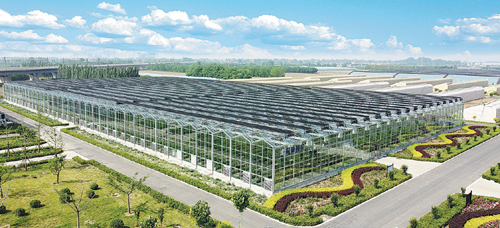Shanxi getting serious on rural revenues
Updated: 2022-08-05

Researchers have planted more than 100 rice varieties in an experimental area in Jinzhong National Agricultural High-Tech Development Zone, aiming to cultivate varieties that are suitable for dryland farming in Shanxi. [Photo by Wang Xiujuan for China Daily]
Modernization of agricultural techniques succeeds in increasing crop yields and farmers' incomes
Shanxi's agricultural industry is on track to achieve high-quality and sustainable development, according to its latest statistics.
The North China province reported an overall added value of 44.87 billion yuan ($6.62 billion) in its agricultural sector for the first half of this year, increasing 5.6 percent from the same period of 2021.
Per capita disposable income of rural residents reached 7,099 yuan during the first six months, growing 6.1 percent year-on-year. The rate was 0.3 percentage points higher than the national average, according to the Shanxi Statistics Bureau.
Local officials said these achievements were made because of efforts to develop an agricultural industry with local characteristics and continuous farming modernization.
One focus of Shanxi's agricultural industry is the high-efficiency growth of its dryland farming.
Shanxi's agricultural experts said that, unlike the south and east of China, dryland farming is the characteristic of local agriculture, because of the relatively lower amount of precipitation in the province.
They believe developing water-saving irrigation, cultivating crop varieties to suit local conditions and improving soil quality are the key elements for better dryland farming.
On June 6, a wheat farm in Yuebi village in Linfen reported a per-hectare yield of 8.7 metric tons, a record for dryland wheat farming in Shanxi.
An official in the village said that the use of new techniques, proposed by local agronomists, is the reason behind the stellar performance. The techniques include soil moisture improvement through deeper plowing and accurate spray irrigation.
Yao Jianmin from Shanxi Agricultural University is one of the local farming experts who offered their know-how, expertise and solutions to Shanxi's dryland farmers.
Over the decades, he has traveled across Shanxi to provide services to farmers in more than 50 counties.
One of his solutions to dryland farming is the use of water-permeable films. "Water-permeable films can effectively prevent evaporation and soil erosion and retain water and nutrition, while allowing roots to breathe better," Yao explained.
In addition to local experts, agronomists from the rest of the country are contributing their solutions to Shanxi's dryland farming.
Guo Hui, from the Nanjing Agricultural University in Jiangsu province, for instance, is leading a team of researchers to work with the Jinzhong National Agricultural High-Tech Development Zone.
The team's mission is to cultivate rice varieties suitable for dryland farming conditions in Shanxi.
"We know that rice varieties growing in the northern part of China have a better quality and taste than those in the southern parts of the country," Guo said. "And the larger temperature difference between day and night in the north is the major reason for this unique quality."
He noted that rice varieties from the north have higher prices than those from the south, so these can contribute to the revenue of growers.
But even in the north, rice is still a water-dependent crop, so it is widely seen in regions with larger amount of precipitation and better water supplies, like Northeast China, according to Guo.
He said that his team has made initial breakthroughs in cultivating dryland-farming rice varieties suitable for Shanxi.
The team planted 110 rice varieties in an experimental area of about 2 hectares, with a great number of them showing adaptability to dryland farming. "We will sort out a few varieties that are most suitable for dryland farming in a period of about five years," Guo said.
In addition to staple grain crops like wheat, cash crops are also playing an increasingly important role in driving rural development.
One such crop is daylily, with the city of Datong as a major producer. The flowers are a popular food ingredient throughout China.
In recent years, the local daylily industry has expanded substantially thanks to the support of authorities.
When farmers are busy collecting daylily flowers during the July-August harvest season, Zhang Qiang, mayor of Datong, was calculating the earnings that the industry could make this year.
"In Datong, the planting area of daylilies is close to 18,000 hectares this year," Zhang said. "We estimate the total revenue generated by the entire industrial chain, from plantation to processing and sales, could reach 4 billion yuan this year."
The entire daylily industry generated a revenue of 3 billion yuan in 2021, according to the mayor.
The daylily industry in Datong offered job and business opportunities to more than 132,000 rural residents in 2021. It also brought an additional per-household income of 5,400 yuan to those in the industry, according to Zhang.
Similar to the daylily industry in Datong, an extended industrial chain for agriculture has been formed in Shanxi. Statistics from the Shanxi Department of Agriculture and Rural Affairs showed that the industries of agricultural product processing and sales reported a combined revenue of 262 billion yuan in 2021, up 20 percent from 2020.
In addition to daylily, other crops like coarse cereals, vegetables, fruits, edible fungi and medical herbs, as well as livestock like cattle and sheep, are forming new specialty industries in Shanxi and creating new sources of income for rural residents.
Wang Xiujuan contributed to this story.



